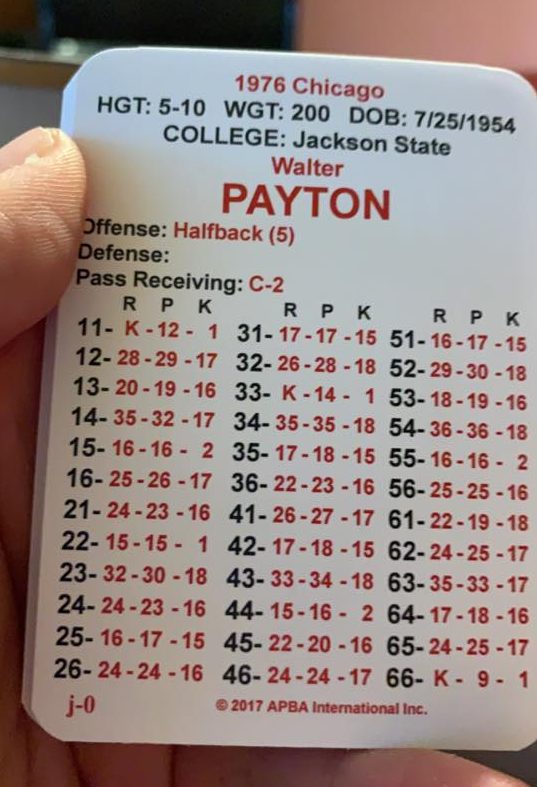
Ken Schulz helps me out again this week. This time, it’s an APBA Football of player who I idolized from time when I loved the NFL. Sweetness! It’s the APBA card for 1976 Walter Payton.
| Game | Rush | Rush | Rush | Rush | Rush | Rush | Rece | Rece | Rece | Rece | Rece | Rece | Scor | Scor |
|---|---|---|---|---|---|---|---|---|---|---|---|---|---|---|
| G | Att | Yds | Y/A | TD | A/G | Y/G | Rec | Yds | Y/R | TD | R/G | Y/G | TD | Pts |
| 14 | 311 | 1390 | 4.47 | 13 | 22.2 | 99.3 | 15 | 149 | 9.93 | 0 | 1.1 | 10.6 | 13 | 78 |
It was Payton’s second year with the NFL and I remember it well. I was a mere 12 years old. For comparison, you can see his APBA card for his breakout 1977 season here.
Ken’s submission, originally posted on Facebook, gave me a chance to learn a bit about the new-fangled APBA Football game. Honestly, it’s really not that new. It’s just been updated since I last played it in the 1980s.
It was asked what the ‘K’ signified (you can see it on the 66 under the R column). Ken and Craig Christian chimed in with some helpful answers:
It’s like a zero on a double column baseball card. Roll again and use the K column.
I like that feature!!
This gives me a chance to plug Greg Barath’s website. “Oguard62” is very knowledgeable about the game and could deconstruct this Payton card a whole lot better than I. Go visit it if you have an interest in APBA Football.
thanks, Ken!!




Some people love the K column to help limit the big breakway runs with what was formerly a 1 at 66 on Payton’s original ’76 card. His original card featured the KB and PB codes to indicate he could serve as backup kicker and punter, although he appears to only have kicked once: a 39-yard punt in his rookie (’75) season. He also originally had an OC-P code to indicate he was a “backup”/less used punt returner, but since he only had one return for zero yards in ’76, looks like a wise decision to simply drop that indication for the new card. He also had a J-3 originally, which meant he’d be out the rest of any game in which he was injured; here the J-0 means he sits a play if injured. — Geoff